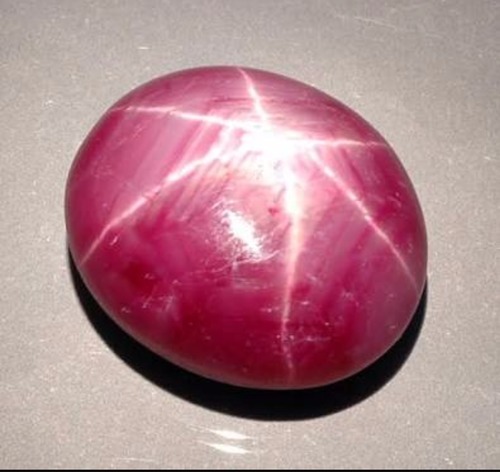Star Ruby
Starting at Rs. ₹40.00 Per Rati
40/- Per rati
Starting Price
Description
Star ruby is a rare variety of ruby that exhibits asterism; a six-rayed star that shimmers over the surface of the stone when it is moved. The star effect is owed to aligned needle-like rutile inclusions. It is the rutile which is responsible for its silky shine. In rough form, ruby is dull and greasy, but when cut and polished its luster is comparable to fine diamond. Ruby is classified as the red form of gem-quality corundum; all other color varieties of corundum are referred to as sapphire. Corundum is the second hardest mineral on the Mohs scale, with a hardness rating of nine. Owing to its superior hardness combined with its rich color and silky shine, fine quality ruby is classed as one of the group of four so-called “precious” stones, along with diamond, emerald and sapphire. Ruby gets its name from the Latin word ‘ruber’, which means red.
Rubies can range in color from pinkish red to orangey, purplish and brownish-red, depending on their chromium and iron content. The most desirable color is ‘pigeon’s blood red’ – a pure red with a hint of violet or blue, only found in the mines of Myanmar (Burma). Star ruby, along with all other forms of ruby, is one of the most valuable types of colored gemstones available today. In fact, large rubies are actually rarer and more valuable than diamonds of comparable size. Ruby is the official birthstone for those who are born in July. Ruby may be also used to celebrate 15th and 40th wedding anniversaries.
Star ruby can often be distinguished by its pleochroism, which means that the color varies with the viewing angle. The six-rayed-star effect shimmers best over the surface of the stone when moved in daylight. Many rubies will fluoresce in long or short wave UV light and this property can often be used to help identify a stone and its geographic origin. Burmese rubies often fluoresce so strongly that the effect is noticeable even in sunlight; such stones seem literally to glow and are greatly admired. Thai stones generally lack this property. Ruby has no cleavage and its hardness is 9 on the Mohs scale. It is the second hardest material next to diamond, which is used as a distinguishing trait.
For centuries, the most important deposits have been in Upper Myanmar (Burma) near Mogok. Only one percent of the production is of gem quality. Some of the rubies are of pigeon’s blood color and considered to be the most valuable rubies of all. In the early 1990s, large new deposits were discovered at Mong Hsu.
Star rubies range in color from pinkish to orangey or purplish and brownish-red, depending on their chromium and iron content. The most desirable color is the so-called “pigeon’s blood,” a pure red with a hint of violet or blue. The distribution of color is often uneven in strips or spots. Color saturation is extremely important.
Transparent ruby is favored, but star ruby actually requires welcomed inclusions. Most star ruby is opaque with some finer materials exhibiting slight translucency. Rutile inclusions cause the six-rayed asterism that converts a ruby into the desired star ruby. The rutile lends ruby a silky luster. Inclusions are common for star ruby and are not always indicative of poor quality. Inclusions commonly found in ruby are used to help distinguish between natural and synthetic ruby. Inclusions may also be used to help distinguish origin.
Star rubies are typically cut en cabochon with very high domes to maximize asterism. Large star rubies are considered very rare. Pear shapes and ovals are most common. Most star ruby gemstones are native cut; this is common for most types of cat’s eye and star gemstones. Cutting of star ruby often necessitates uneven bottoms in order to properly orient and best display asterism (star effect).
Rubies can range in color from pinkish red to orangey, purplish and brownish-red, depending on their chromium and iron content. The most desirabl
For a long time India was considered the classical source for rubies. In the Sanskrit language ruby is called “ratnaraj,” which translates as “king of gemstones.” In ancient times one of the chief attractions of ruby has been a belief in its protection from misfortune and bad health. Ruby is the birthstone for those who born in July. In the zodiac scheme, ruby is sometimes associated with Capricorn. Ruby is also used to celebrate a couple’s 15th and 40th anniversaries. In Antiquity, as well as in the Middle Ages, people believed that the cosmos was reflected in gemstones. Ruby is assigned to the planets Mars and Pluto. The esoteric movement revived this ancient belief and the gem industry made it another marketing tool to promote certain gems. The healing powers of gems remain a controversial issue, but have been mentioned for centuries by healers, shamans and medicine men. Whether it’s based on fact or a placebo effect is unimportant, if it helps. The safest approach is to wear the gemstone in direct contact with the troubled part of the body. Ruby is said to be a general health protector and, in particular, to be good for backache and toenail problems.
Famous star ruby stones of outstanding beauty and color are the “Rosser Reeves Star Ruby,” of 138.7 ct, which can be seen at the Smithsonian Institution in Washington, and the “De Long Star Ruby,” weighing 100 ct, at the American Museum of Natural History in New York.


Reviews
There are no reviews yet.